Why aren't more TV freelancers jumping into YouTube?
And if you want to start building a channel, what should your first step be....
Hello! This week I’ve written one long piece about something I’ve been wondering for while, which is why are we not seeing more TV production freelancers getting into YouTube, especially considering the size of the opportunity and the state of the TV market. I’ve shared my thinking but perhaps you have other insights - drop them into the comments below. I’ve covered:
Some common beliefs (and a few misconceptions) about YouTube
The tasks involved in creating YouTube videos, and the similarity with TV production
The single biggest mistake TV producers can make when trying to succeed on YouTube
Some case studies showing how creators have found their audiences
Beginning to unpack the YouTube advertising model
Which 46 minute masterclass to watch if you want to find out more
Next steps if you are thinking about becoming a creator.
And as always, send feedback - especially if there are particular things to want to know more about - to hello@businessoftv.com.
If this is your first time reading, please do subscribe, you’ll be joining over 1,300 1,400 other TV, film and online content professionals from across the world.
—
Before getting going, here is another little reminder to get your ticket to Create London on April 30th and use the discount code below.
Join the Evolution of the Creator Economy at C21’s Create London Festival
C21’s Create London Festival is a one-day event on April 30, celebrating the creator economy and bringing together creators, TV/film producers, digital platforms, commercial partners, commissioning brands, and AI technologies.
Be part of the creator economy’s next chapter - secure your place today HERE!
Exclusive Offer: Business of TV subscribers receive 20% off the current ticket price with code VIP20 at checkout.
—
Why aren’t more TV production freelancers getting into YouTube?
I have spent pretty much all of my career with a foot in each camp of TV and what is referred to as ‘digital’ - meaning the world of content, products and services delivered over the internet to audiences.
These two camps have very different vibes right now if my LinkedIn and social feeds are anything to go by. The TV conversation is one where many freelance production professionals are struggling to find work while simultaneously trying to cope with the mental strain of the state of our industry. It is heartbreaking to read, and worrying both for individuals but also our culture and economy to see the level of turmoil engulfing what has been such a significant success story.
Meanwhile, the digital camp is one characterised by enthusiasm if not at times mania; a global gold rush as people chase down opportunities and build businesses in a frenzy in what is broadly called the creator economy.
While the creator economy can cover all sorts: newsletters, social, podcasts, membership clubs and communities, unsurprisingly I’m going to focus on YouTube. This is the world’s audio visual storytelling platform to reach people interested in your content, and then monetise that attention at the click of a button. Unlike previous internet driven waves, to become a creator requires next to no technical skills beyond simple consumer apps, an iPhone and some editing software; you don’t need to learn a coding language or be steeped in complex engineering. Of course, many won’t succeed, however the tools and services are now there to enable anyone in the world to create content, find audiences and in theory, make money.
With that in mind, it should be the natural home for people who produce TV shows, especially those who are producers, directors and editors. And yet, why are TV production freelancers - some of the best audio visual storytellers in the world - not leaping into this space, and instead have been leaving the playfield to others who are maybe fitting their YouTube activity around their day jobs, often in potentially unrelated sectors?
I think there are many reasons that freelancers are not (yet) part of the creator gold rush (and there are other blockers for production companies - I’ll do a separate post on companies next week).
As a starter, here are some beliefs which could explain why in general freelancers have not yet seen YouTube as a viable option.
Some common beliefs (and a few misconceptions) about YouTube
YouTube is a separate market to TV
It appears that some continue to view YouTube as an adjacent market to TV, and perhaps closer to distribution, marketing and advertising. Indeed, if TV production people come into contact with YouTube for a TV show they are working on, often this activity is managed by separate social or marketing teams within broadcasters, thus reinforcing it is ‘different’ to the TV commissioning and production process (although this is becoming less common). In reality, thanks to convergence, increasingly TV and YouTube are in the same market together, battling it out for attention on the connected TV set. More on that here:
YouTube is a place for short form, influencers and skateboarding cats
The reputation of YouTube as being a place for influencers talking about their wardrobes, how to videos and games walkthroughs continues as a hangover of the 2010s, even though there has and continues to be increasing professionalisation and ambition within the creator economy.
Durations is another area where out-of-date information still lingers - while short form used to be the ideal length, YouTube has been prioritising long form content for some time now, especially considering half of the viewing of YouTube is on connected TVs (worth mentioning they also have their vertical Shorts format which is a competitor to TikTok and Reels).
The chance of success is too low and the business model too tricky
Perhaps there is a belief that being a creator sounds too good to be true; that there must be a catch somewhere. Considering how hard people have to work in TV to succeed, the idea that you can create some videos and get paid seems a little too close to a get rich quick scheme. Plus some TV people have seen others try and fail to ‘do’ YouTube, and therefore this adds to the skepticism about it as a genuine and realistic opportunity. In relation to this, some question whether there really are revenues here for the bulk of creators. Yes of course, MrBeast makes a fortune, but beyond him and a handful of others, is everyone busting a gut to only get a few dollars here and there? Finally, the YouTube revenue model is fairly well known, where even millions of views won’t begin to cover the cost of an average TV production budget, which funds the size and scale of productions TV freelancers are used to.
The solitude of being a creator isn’t appealing
Is the job of being a creator and all that it entails unappealing for those who chose to get into TV production? TV by its very nature is an exciting industry to be part of; production involves huge amounts of collaboration, working in partnership with a whole range of people, different each day, much of it on locations in all sorts of exotic (or less exotic) places. The production cycle is longer, often taking months if not years to deliver a project, and then it lands with a (hopeful) splash where your friends and family see your show and it is talked about in the media and trends online. For many creators, especially those starting out or with smaller channels targeting niche markets, the job is much more akin to being a solo entrepreneur or having a micro business; working on your own with a regular publishing schedule that could be weekly or bi-weekly, and where you have to obsessively check your stats and your users. So not only could this be a little lonely for TV producers who chose one of the most sociable professions out there, it also could feel harder to tell stories that make a big splash in the same way as you can with TV.
If these are some of the reasons that TV freelancers haven’t not in general made a leap into YouTube, well, some of them are fairly legitimate observations. After all, there isn’t a guarantee of success. The business model is tricky and doesn’t map onto the size and scale of TV production both in ambition and budgets. Being a creator can mean working alone as a slave to the algorithm. It is harder to make a splash with a YouTube channel than a show on prime time TV. And with all the creators flooding the market with content, there is a real risk that there isn’t enough advertising money to keep up with the views on all these channels.
It is worth noting however that some of these beliefs are increasingly outdated. For example the idea that TV is a separate market to YouTube, or that it is only short form and influencer type content that works there. In addition, some of the other factors especially around the revenue model might be temporary as the platform matures over the coming years, and as more brands, talent, studios, broadcasters and advertisers invest in channels.
What tasks are involved in being a creator, and where to do they crossover with TV production
For those freelancers struggling to get work and are maybe considering getting out of TV entirely, is there an option to consider the creator market as a natural home for your skills and experience? If you look at the (high-level) tasks of being a successful creator, they include:
Researching and drawing up a channel plan
Creating a content plan
Producing videos
Marketing your videos
Engaging with audiences
Analysing data.
Some of these are new to TV freelancers; marketing, audience engagement and perhaps analysing data. However other elements - especially drawing up editorial plans and producing videos - are routine parts of the TV day job, especially for those who can shoot and edit.
Or to illustrate it another way, I spotted someone sharing a list of 60+ topics for YouTube creators to think about. Again, some of these will be new to TV producers, but many of them are just routine bread and butter tasks of the telly day job:
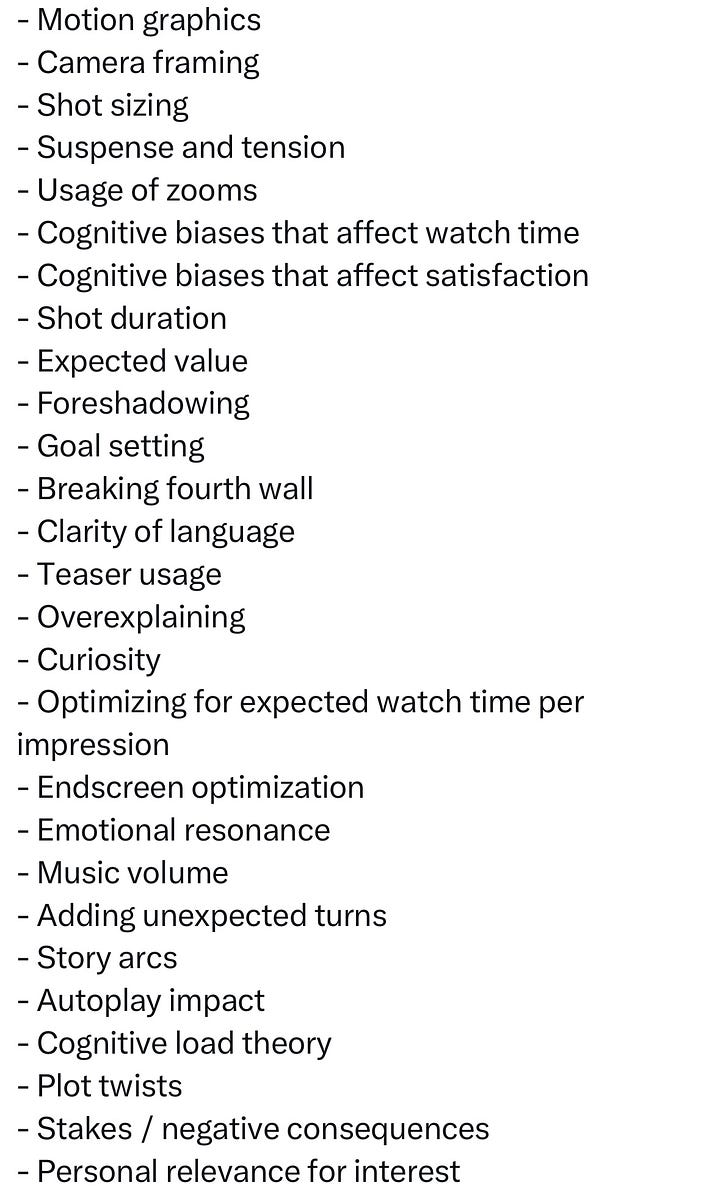
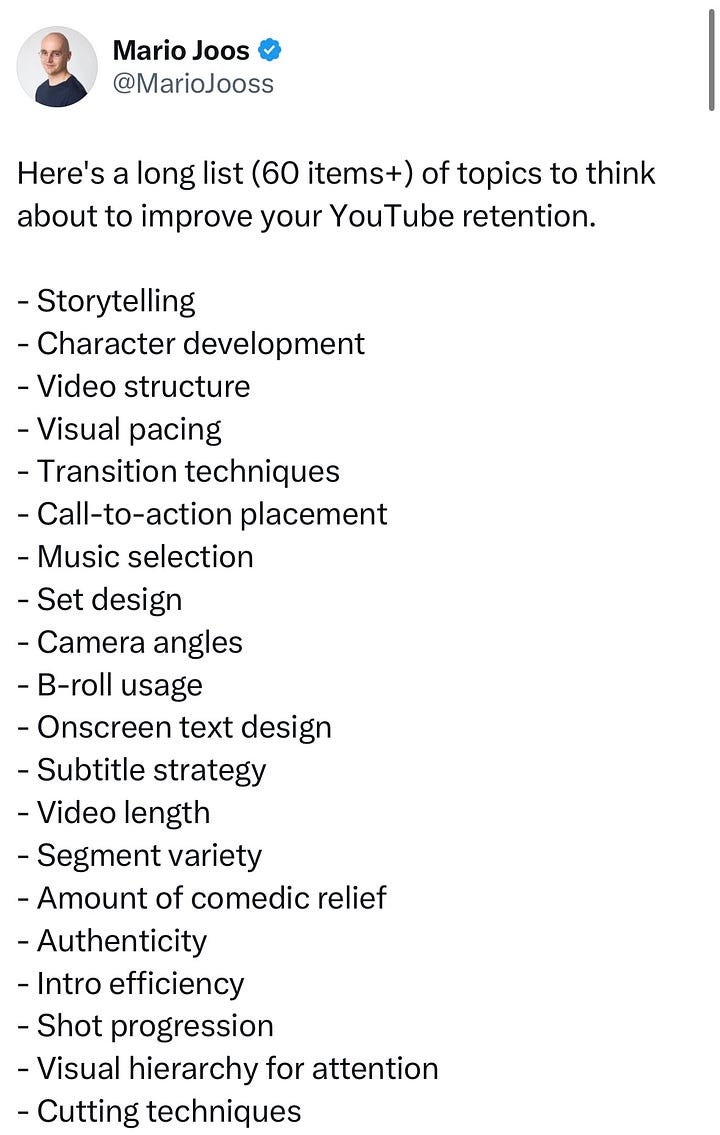
And just this week, YouTube published a piece giving tips to creators on how to produce videos for the TV set. Looking through the list, and so much of what is detailed there is second nature to those who make TV shows. So from this perspective, TV freelancers often are already experienced in many of the core skills involved in succeeding on YouTube.
The single biggest mistake TV producers can make when trying to succeed on YouTube
Where TV can set itself up to fail on YouTube is in how content is developed and released to audiences, and the pretty major difference in approach between TV and the creator economy.
For creators (indeed, anyone publishing to the internet), an essential approach is what is called iteration, or test and learn. This is where you create something, publish it, see if it gets any traction, if it does great, do more of that, if it doesn’t, go back and try again. And ideally, this loop is run fairly quickly and frequently, so momentum isn’t lost before finding something that works. The idea is to keep plugging away, trying things out to see if anything flies, and when it does, double down on it.
This is completely different to TV where the show is made and iterated on behind the scenes before being revealed as a finished product to audiences. This approach is great for everyone involved in TV, as audiences and advertisers have high quality expectations and so want a polished finished show. Plus the cost has been covered by the broadcaster so if a show doesn’t work, the producers aren’t out of pocket.
Applying this same approach to YouTube is highly risky, because if the videos don’t work, well that is a lot of money down the pan as they won’t get views and therefore they won’t generate any ad revenue. As well as losing money, this also has the psychological effect that the initiative is viewed as a failure, and therefore it makes it less likely for everyone involved to try again - so the essential iterative cycle dies at this point.
For TV freelancers - or indeed anyone - to succeed on YouTube, committing to the test and learn cycle is vitally important.
Some examples of how creators iterate to find their audience
To show how test and learn can work in practice, I’ve used
as an example. I included his channel in my list of news and current affairs YouTubers a few weeks ago:Brendan is current affairs producer (ex of Question Time) and over the last year we can observe him going through a test and learn process to find out what works with audiences. He has tried different topical subject matters, thumbnails (often featuring himself) and types of titles. He had limited success and then had a modest uptick with the video in the middle called ‘The right cancelling free speech’ which got 31k views:
Now look below at his most recent videos. He did a video on one of the biggest journalist YouTubers, Johnny Harris, two months ago which got some traction (187k views), and then found a mix of both subject matter and arresting thumbnail design that really started to work with the three videos on Trump:
I suggest going and watching the videos themselves. They aren’t expensive to produce and use an explainer format of news footage with Brendan talking to camera at a desk (I’ve written separately about the issue of clearances but it is something important to consider). Also have a look at the number of comments below his videos - he’s starting to attract an engaged audience.
The above example is happening in real time so we can watch how Brendan’s channel develops over the coming months. Another example is DodfordYT, but this time we are looking backwards at a channel that has gone on to be a big hit. I included his channel in the list of documentary YouTubers below:
Dodford recently posted to X an image of his channel from 2 years ago. Look in particular at the Nardwuar video on the left with 23k views, and The Sidemen video on the right with 752k:
And here are those same videos today - in two years The Sidemen video has only gone up to 858k views, however the Nardwuar one went up to 2.8m:
The conversation on X is worth reading, to see how Dodford views his success and how he managed to build an audience. He mentioned this video below in particular, as he says it was the first video he produced that got traction:
Unpacking the YouTube advertising business model
Using Brendan Miller’s channel as an example, we can hopefully see how the YouTube revenue model works in practice. Big caveat that I’m using publicly available data, so actual revenues are only known to channel owners.
The videos he’s published in the last year have generated in total 3.2m views, which could have made around £6k to £12k in revenue after YouTube’s share - not exactly going to keep the wolf from the door. However not only will each of these videos continue to rack up views and thus revenue, if he adds another video each month for the next year, and if each one does on average say 1.5m views, by the end of 12 months he might make somewhere around £80k to £100k net of YouTube’s share and before his costs. And if his videos do better than 1.5m - say on average 2m views each - well that is £110k to £130k he’ll earn. If they do worse - on average 1m views each - then he might make £60k to £85k. Again, all approximate estimates, and earnings can fluctuate wildly depending on the territories of audiences, the category, the duration and number of ad placements.
I have no idea if it is just him or others working on this channel, but if he is a solo creator and the costs are his time, a laptop, a phone, and maybe a little more for some graphics, well then that leaves the bulk of the revenues for his pocket.
To use another example, even if you build an audience but your production costs outstrip your revenues, well like any business, it isn’t going to work in the longer term. Previously I wrote about YouTube creator Carla Lalli Music who recently announced she was stopping creating YouTube videos despite having generated 18m views and 230k followers. This was because her costs were $14k per video and her advertising earnings were $4k per video. She then took on sponsorship deals to cover the other costs, but this wasn’t generating a profit.
She has written about her experiences, but ultimately when you view her videos you can see that the slickness, number of crew and level of graphics pushed up the price per video beyond what was sustainable so something had to give. She said she didn’t shoot or edit her videos herself, therefore had to pay someone else to do this work which basically blew her revenue model.
What to watch if you want to find out more
If any of this has turned your head, then I’m guessing the follow up question is what to do next. There are a zillion different places to find information, training and the like on how to be a creator (and be warned, not an insignificant number of charlatans).
The place I’d suggest starting is to watch this 46 minute Colin & Samir video below, which is time very well spent on how to start thinking about YouTube:
Next steps if you want to explore being a creator
And if after watching that you are still intrigued, then perhaps you might start think about what interests you have, what niche could you target, what is your TV specialism, can it be converted into something that appeals to a global niche, what other players are there, is there a gap in the market? How can you keep your production costs down while also creating content that is appealing to a particular audience? Who else is operating in this space and what brands are sponsoring those channels? Can you develop an authentic and appealing offering? What TV skills can you use and what parts of the production process are unnecessary when not producing to TV’s requirements?
If you sense an opportunity, then Colin & Samir (and others) have a wealth of information as well as paid courses on how to plan out your strategy and give it a go. In this space, many others have tried and failed and tried and succeeded, so learning from them is a crucial shortcut. As previously mentioned, there is a lot of chatter in this space, so I’ll come back to this again in the future on how to identify who is worth listening to, what to look for and some warning flags when hunting expertise in this market.
And if you are still not sold, then why not consider the very worst thing that could happen? At the end of (say) a year or possibly two, is the worst outcome that you’ve not managed to find an audience? Perhaps, but you’ve learned how YouTube works, which is hugely valuable to all sorts of employers. And the best result is you’ve started to build an audience and earn direct money. Who knows, it isn’t impossible some might even earn more than they did as TV freelancers.
All the while I’d encourage anyone looking to get into this space to have the words of Sam Barcroft ringing in your ears or perhaps even tattooed on a body part:
The people that make the decision to make YouTube their number one priority above all else are the only ones that will prosper in the end.
Everyone else will be likely wasting their time.
YouTube is the natural platform for TV producers however being great at telling audio visual stories isn’t enough. To succeed also requires a commitment to an iterative test and learn process, the development of some new skills (marketing, scheduling, community management and data analysis), and much more importantly, it needs a hungry, committed and focussed attitude.
In other words, YouTube isn’t hard in the sense it doesn’t require you to become an engineer or learn a new coding language. Rather, it is hard work, and you’ll need to live, breathe and eat your channel to have a chance of success.
But jolly hard work is hardly a strange concept to those working at the coalface of TV production, is it?
—
So that’s my take - what is yours? Does any of this resonate? What have I missed? Do comment below….
If this is useful, please do share it with your colleagues or anyone you think might be interested:
Find out more about me and the purpose of this newsletter, say hi via email hello@businessoftv.com, or connect with me on LinkedIn.









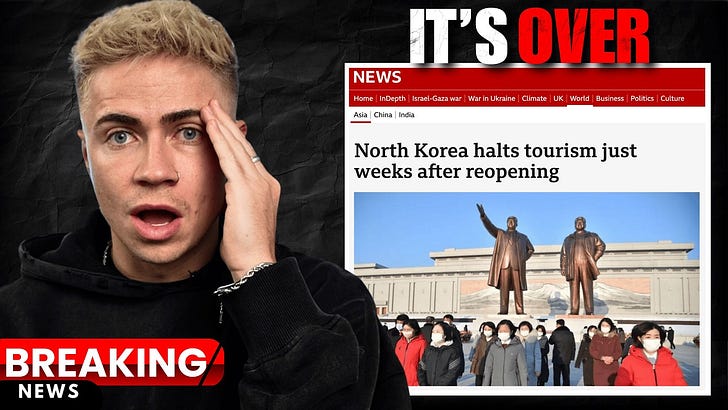

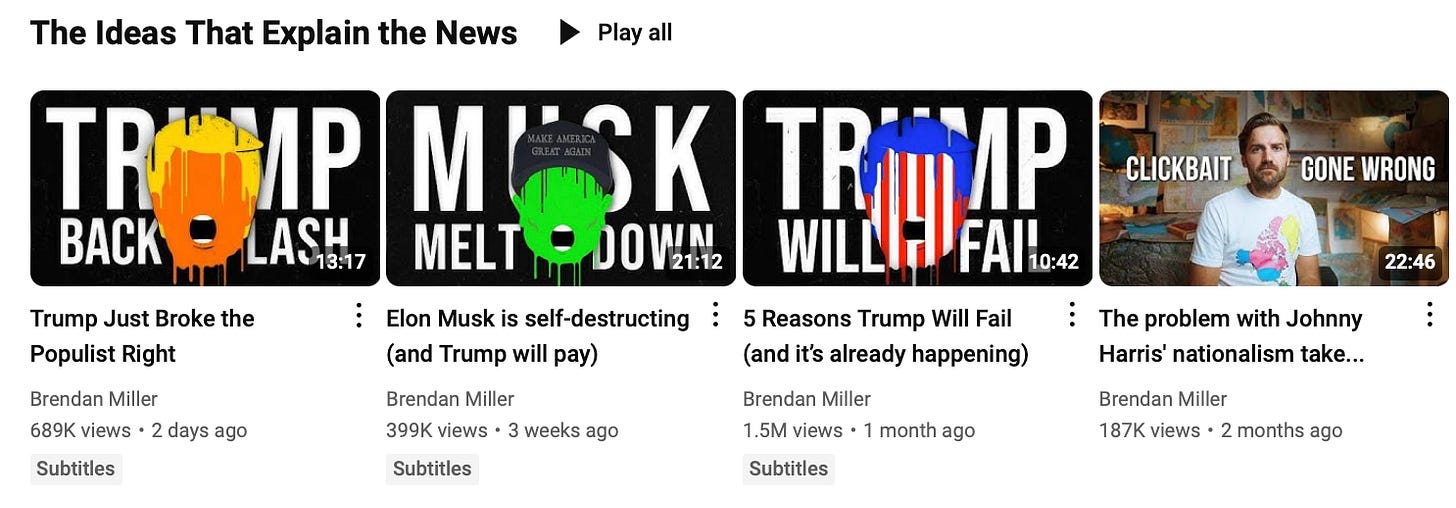
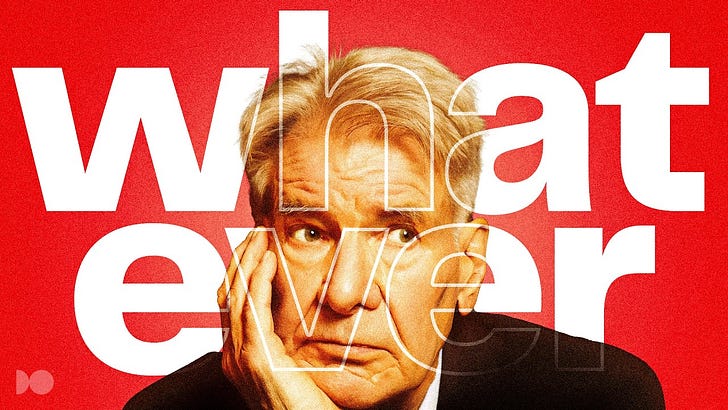


My revenue in the last year has been £7k - 90% of that in the last few videos. However after the new attention I should be able to get sponsored ad read opportunities, which seem to range but can be $5000 dollars. That'll be a game changer.
Do you have any insight on how to make narrative filmmaking work on YouTube?